
* The Pipistrel aircraft company of Slovenia started out building ultralight aircraft, eventually working their way up to the "Sinus" powered sailplane, and its short-winged "Virus" equivalent. Pipistrel has since diversified into electric aircraft and drones. This document provides a history and description of Pipistrel's aircraft.
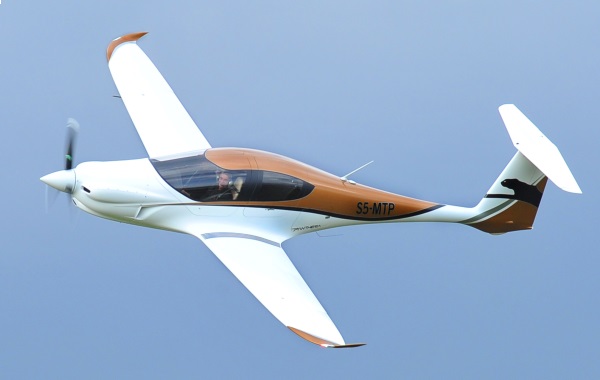
* Pipistrel got its start in 1982, when Slovenia was part of Yugoslavia. Two sailplane pilots and RC model-builders named Ivo Boscarol and Bojan Sejovic decided to expand their horizons. Consulting and working with like-minded individuals, they began to produce "trikes", as something of a "garage job". The Yugoslav government was not keen on do-it-yourself aircraft development, and so the trikes were flown in the evening.
It wasn't until 1987 that the team got official authorization to produce aircraft, with the first "series" trike, the "Basic", introduced in 1989, and the "Plus" following in 1990. The company was formally established in 1992, with the trikes sold internationally, Pipistrel establishing relationships with a number of foreign distributors. Pipistrel sold both kits and assembled aircraft.
Slovenia declared independence in 1991, leading to a ten-day conflict with Yugoslavian forces -- but Slovenia was able to stay out of the rest of the bitter fighting that took place over the decade. It was at the north of what had been Yugoslavia, nestled between Italy, Switzerland, and Austria, bringing it closer to the orbit of Western Europe. However, early on, Pipistrel sold a number of trikes to Croatian forces, some being equipped with floats.
The Pispistrel Company was formally established in 1992 -- "pipistrello" being the Italian name for "bat", which was the nickname of the early trikes, since they were flown at dusk. By that time, it was producing 3 or 4-blade composite propellers, capable of being adjusted on the ground, providing a regular cash flow. The company also established partnerships with foreign firms. An improved "Spider" trike was introduced in 1992, followed by the "Twister" in 1998. Pipistrel gave up making trikes in 2000, having sold hundreds to that time.
The company had begun to shift focus from the middle of the decade, introducing their first "proper" ultralight aircraft, with the initial prototype of the "Sinus" -- pronounced "Seenus" -- two-seat motorglider taking flight in 1996. It was followed in 1997 by a prototype of the "Virus" -- pronounced "Veerus" -- which was much the same as the Sinus, but had shorter wings. Both were in mass production by year 2000.
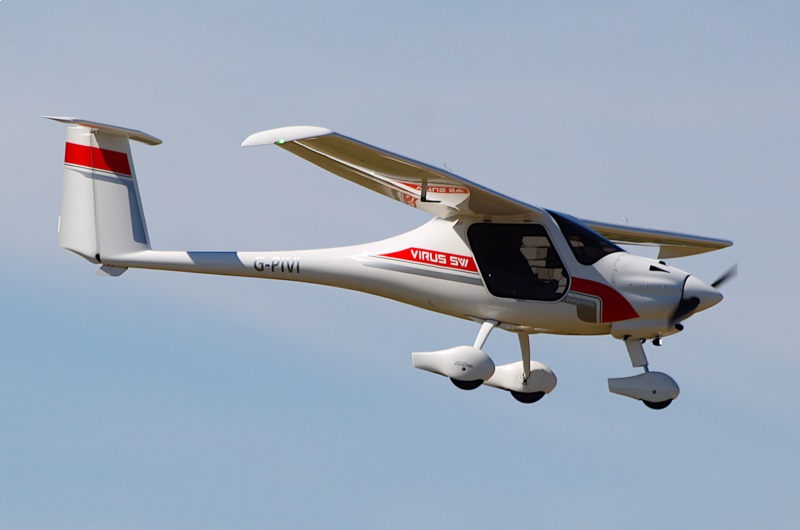
Incidentally, Pipistrel has never far gone out of their way to explain the logic behind the naming of their aircraft. These two names are Latin in origin, but their rationales are unclear: "Sinus" is for "cyclical wave", suggesting soaring flight -- but the company has leaked the thought that the Virus might be hoped to "go viral", suggesting there may be a bit of pranksterism in them.
Using the wings and tail of the Sinus, Pipistrel developed a single-seat sailplane, the "Apis" -- Latin for "Bee" -- which was actually sold by a partner company, Albastar, with a powered version also built. It led to the Pipistrel "Taurus", which was similar, but a two-seater.

In 2004 -- the same year that Slovenia joined NATO -- Pipistrel began production from their own factory in Ajdovscina, Slovenia. There are a lot of companies that build ultralights and kitbuilts; Pipistrel was beginning to emerge from the pack. In 2007, the company flew a prototype of an electric version of the Taurus sailplane, the first step towards Pipistrel becoming a leader in light civil electric aircraft.
In 2008, Pipistrel began selling an improved version of the Apis, calling it the "Bee" in countries where the Apis name was trademarked. The company also introduced a short-wing version of the Virus, named of course the "Virus SW". That same year, Pipistrel set up their own solar-power plant, at the time the biggest in the Balkans; it was clearly to support their own facilities, but it appears it also provided power to the community.
From that time, Pipistrel became increasingly focused on innovations, flying the "Taurus G4" in 2012 -- an engine-test demonstrator, being two Taurus sailplanes mated side-by-side, with a center-wing prop module. That same year, the company:
A survey-surveillance variant of the Virus SW, the "Surveyor", was introduced the next year, 2014. A "WATTsUP" electric-powered demonstrator, based on the Alpha, flew in 2015.
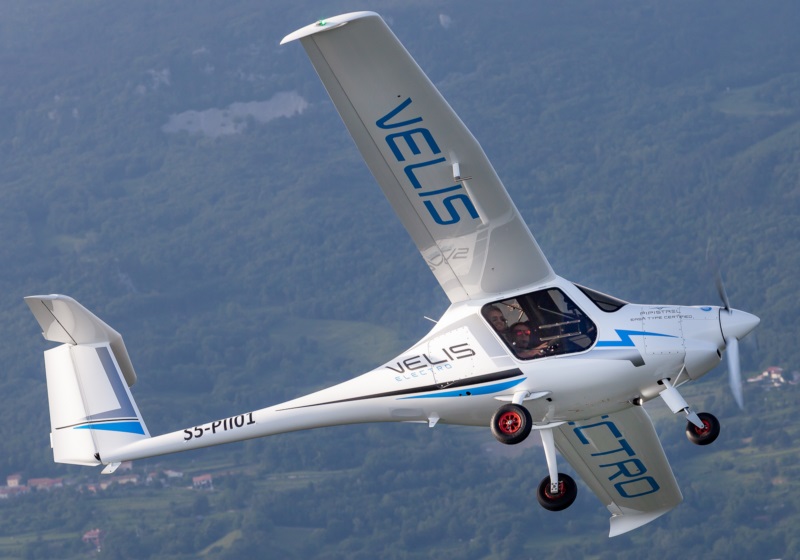
The "HY4" -- a demonstrator for hydrogen propulsion, an update of the Taurus G4 -- flew in 2016, with an "Alpha Electro" -- a production version of the WATTsUP -- flying in 2018. A "Velis Electro", a Virus SW with electric propulsion, was introduced in 2020, being intended primarily for training. It was followed by the "Velis Club", also primarily a trainer, with a Rotax 912 ES engine; it was rather like an Alpha trainer with Virus wings.
By that time, Pipistrel had (more or less secretly) introduced a drone version of the Sinus-Virus, and was working on a series of cargo drones, with plans for electric vertical take-off / landing (eVTOL) aircraft. In 2021, Pipistrel signed an agreement with Genevation Aircraft of Hungary, for license production of the Virus SW. This is expected to help sales of Pipistrel machines in the East, Central Asia, Africa, Turkey, & Israel.
BACK_TO_TOP* The Pipestrel Sinus motor glider, as introduced in 1995, was a high-wing, tee tail aircraft of composite construction, including fiberglass, carbon composite, and kevlar. It had fixed landing gear in either taildragger or tricycle configuration -- the tricycle configuration appears to have been the norm -- with removeable spats on all wheels except the tailwheel. The nosewheel was steerable via rudder pedals.
The Sinus was powered by a Rotax engine, possible fits including the Rotax 447, 503, or 582 -- all two-cylinder inline, two-stroke air-cooled engines, with power ratings of 30, 37, or 48 kW (42, 50, or 64 HP) -- and the Rotax 912 -- a flat-four, four-stroke engine with hybrid air-water cooling, providing 60 kW (80 HP). The Rotax 912 eventually became the default, after Rotax got out of the two-stroke business. The engine drove a two-blade variable-pitch feathering prop, built by Pipistrel. There were fuel tanks in the wings, providing 60 liters or optionally 100 liters (16 or 26 US gallons) of capacity.
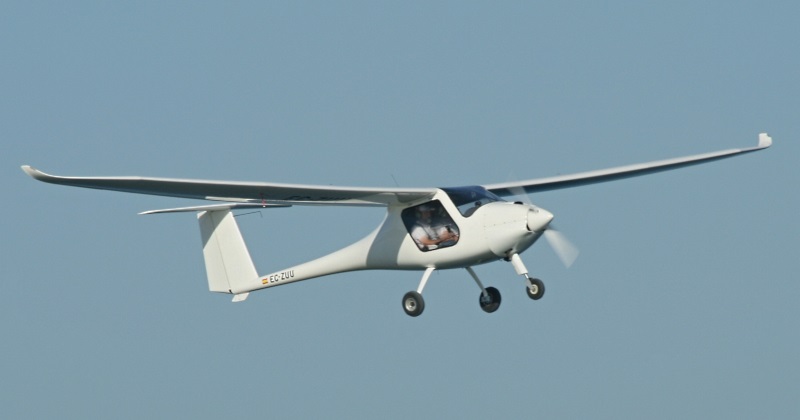
The long-span wing had upturned wingtips. Flight control surfaces included rudder, elevators, full-span "flaperons (flap-ailerons)", a spoiler above each wing, and trim tabs. The spoilers were "lift dumpers", to encourage the aircraft to return to earth on landing -- it was so aerodynamic that it didn't want to. All control surfaces were manually actuated, the flaps by a lever with three flap positions.
There were two seats, side by side, with the cockpit accessed via top-hinged doors; one door could be removed if desired. There was a small baggage compartment behind the seats, with an optional side luggage door. Both seats had stick and rudder pedals; there was a single throttle in the center. A ballistic (safety) parachute was offered as an option; fit of the parachute cut baggage load.
____________________________________________________________________
PIPISTREL SINUS 912:
____________________________________________________________________
wingspan:
14.97 meters (49 feet 1 inch)
wing area:
12.26 sq_meters (132 sq_feet)
length:
6.6 meters (21 feet 8 inches)
height:
1.7 meters (5 feet 7 inches)
empty weight:
285 kilograms (628 pounds)
MTO weight:
600 kilograms (1,320 pounds)
max speed:
220 KPH (140 MPH / 120 KT)
cruise speed:
200 KPH (120 MPH / 110 KT)
service ceiling:
8,000 meters (26,250 feet)
glide ratio:
27:1
range:
1,200 kilometers (750 MI / 650 NMI)
____________________________________________________________________
* The Pipistrel Virus two-seat sport aircraft, introduced in 2000, was very similar to the Sinus, the only major difference being short wings, with downturned wingtips. Like the Sinus, it was available in taildragger or tricycle configuration, featured full-span flaperons plus spoilers / lift dumpers, and optional baggage door. Later production had the ballistic parachute option. The Sinus and the Virus offered a series of cockpit options that evolved over time:
The engine at introduction was a Rotax 912 with 60 kW (80 HP). Fuel supply was the same as the Sinus, either 60 or 100 liters in the wings.
____________________________________________________________________
PIPISTREL VIRUS 80:
____________________________________________________________________
wingspan:
12.4 meters (40 feet 10 inches)
wing area:
11 sq_meters (118.4 sq_feet)
length:
6.5 meters (21 feet 4 inches)
height:
1.85 meters (6 feet 1 inch)
empty weight:
285 kilograms (628 pounds)
MTO weight:
450 kilograms (992 pounds)
max speed:
265 KPH (165 MPH / 145 KT)
cruise speed:
225 KPH (140 MPH / 120 KT)
service ceiling:
8,100 meters (26,600 feet)
glide ratio:
24:1
range:
1,280 kilometers (795 MI / 690 NMI)
____________________________________________________________________
The short-wing "Virus SW" cut wingspan to 10.71 meters (35 feet 2 inches), with an increase in speed and a reduction in ceiling. The "Sinus Flex", introduced in 2013, looked like a Sinus, but the wingtips could be swapped out to give it a Virus or Virus SW wing. Apparently the rest of the aircraft was not the same as the Sinus, but a Sinus could be refitted with the Flex wing.

A number of engine options were offered for the Virus SW:
The Pipistrel "Alpha" trainer, introduced in 2012, was essentially a Virus SW 80 with a cost-reduced airframe, stronger landing gear to handle rough landings, basic cockpit control layout, and ballistic parachute as standard. India also obtained 194 trainers based on the Virus SW 80, with the Indian Air Force obtaining 72, the Indian Navy 12, and the National Cadet Corps 110. They were named "Garud", after a divine bird of Hindu mythology. Deliveries were from 2016 to 2019. Their exact configuration is not clear.
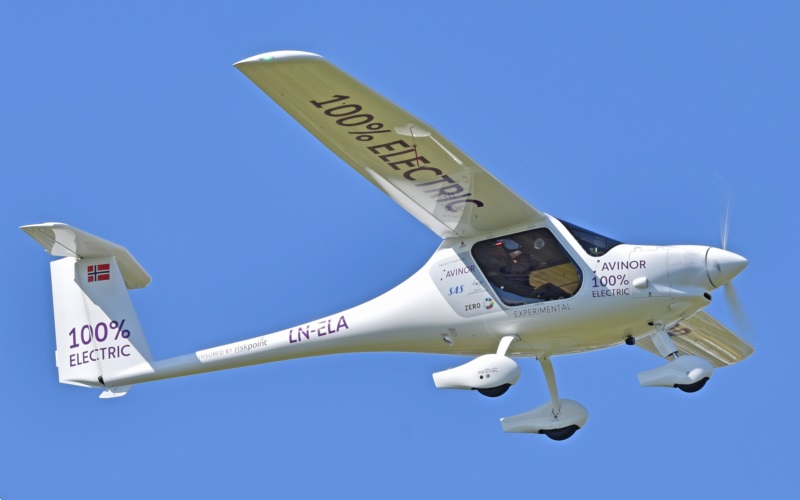
Followed tests of a "WATTsUP" demonstrator in 2014 -- an Alpha fitted with a Siemens electric motor providing 85 kW (114 kW) -- Pipistrel introduced the "Alpha Electro" in 2015. It was powered by a Pipistrel E-811 electric motor, designed in cooperation with Emrax and Emsiso of Slovenia, proving 60 kW (57 HP) continuous power. Power was supplied by a lithium battery pack that provided an endurance of an hour. The battery pack was several times heavier than a gasoline fuel system, but the motor was much lighter than the Rotax 912, and the airframe was trimmed in weight.
* In the meantime, Pipistrel developed a remote-sensing version of the Virus SW, named the "Surveyor", and introduced in 2014; it was also available with the Sinus long wing. Instrument payloads were highly variable, as per customer requirement: cameras and other instruments could be installed in the payload pay, with ports in the floor, and a sensor turret could be installed under the left side of the nose, or under a wing. Indeed, Pipistrel made sure kit could be installed almost anywhere it made any sense to put it.
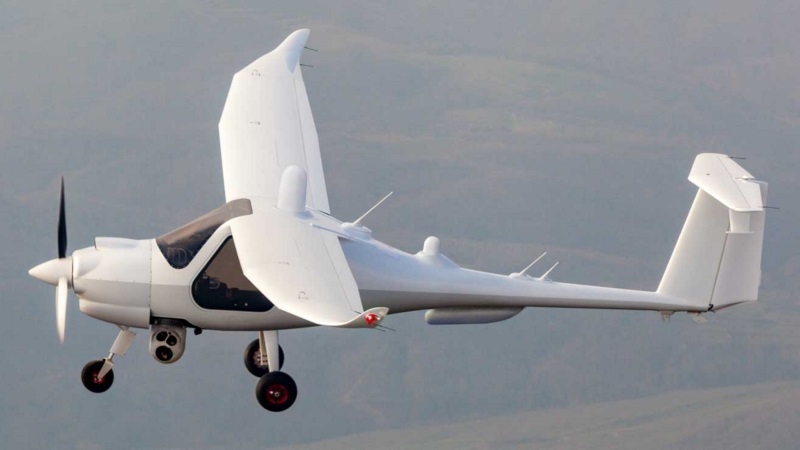
The Surveyor's development was in parallel with an "unpiloted aerial vehicle (UAV / drone)" variant of same. The work has been largely secret, but it was primarily driven by the US Special Operations Command (SOCOM), under a "Long Endurance Aircraft Program (LEAP)", with the Pipistrel drones in operation from 2013. Not much is known about the LEAP machines, other than that they have the Sinus wing, having long endurance, as well as being very quiet. They carried day-night imagers and signals intelligence gear. One crashed on landing in Iraq in 2020, giving a glimpse into the LEAP program.
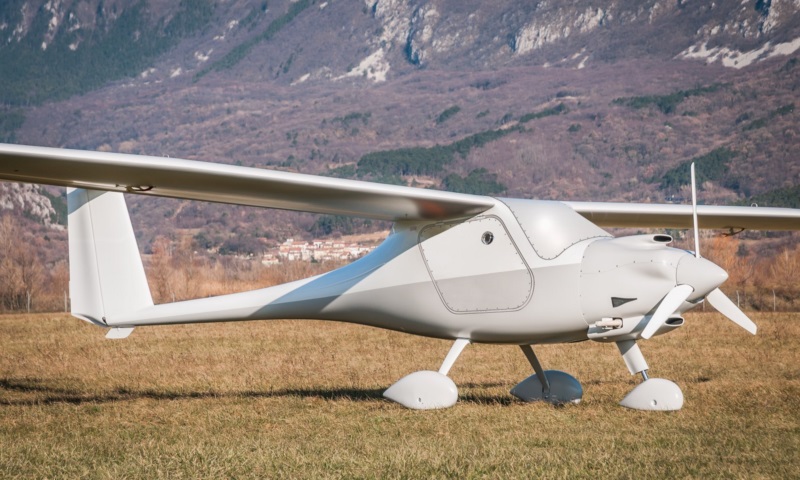
Pipistrel offers a drone version of the Surveyor. The company is also working on a cargo drone based on the Alpha Electro, to be used for missions such as humanitarian relief, the aircraft having a cargo load of 115 kilograms (250 pounds). Cargo would be dropped from a pod under each wing. Over 1,000 Sinus-Virus machines have been built to date.
BACK_TO_TOP* As mentioned, Pipistrel designed the Apis sailplane, which performed its first flight in 2000, for its partner Albastar. It was a single-seater of composite construction, with a tee tail, mid-mounted wings, and bicycle landing gear -- a steerable tailwheel plus single wheel under the cockpit, which retracted electrically, along with a roller under each wingtip. The flight surfaces were taken from the Sinus, featuring upturned wingtips and long-span flaperons. It seems Albastar actually built the Sinus wings for Pipistrel.
The canopy hinged open from the front. Length was 6.35 meters (20 feet 10 inches), wingspan was 13.3 meters (43 feet 8 inches), and empty weight was 135 kilograms (300 pounds). A lightened version was developed as a record-setting platform, and set five records.
The original "Apis 13" was followed in 2002 by the "Apis 15", with a 15-meter (49 foot 2 inch) wingspan. It was followed in turn by the "Apis 15M", which was a powered version, using a two-cylinder Hirth piston engine on a pop-up arm behind the cockpit, with the engine driving a two-blade fixed-pitch wooden propeller. An "Apis 15MB", with a ballistic parachute, was also introduced.
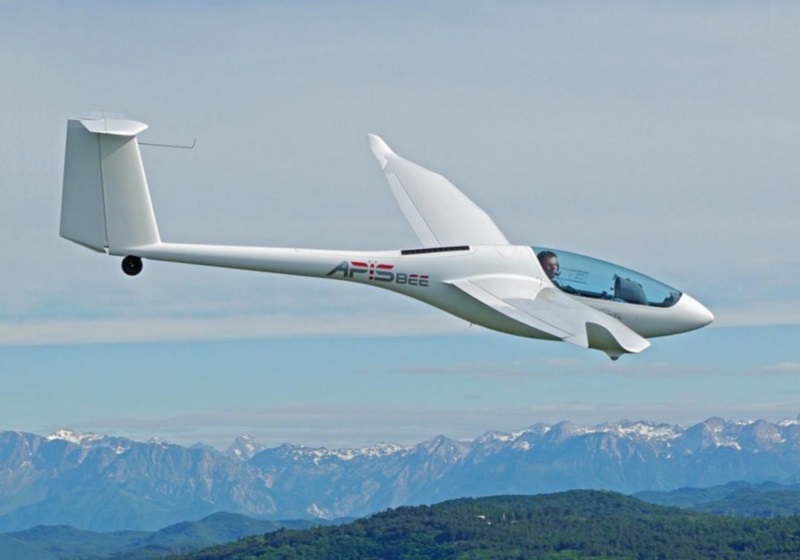
The last Albastar Apis was built in 2008, with Albastar going on to other sailplane designs. In 2009, Pipistrel introduced an improved Apis 15, also sold as the "Bee" in some countries to get around copyrights. It was externally identical to the original Apis, but featured a number of refinements:
In addition to the Apis 15, 15M, and 15MB versions, Pipistrel also introduced an "Apis electro 15", with electric drive.
Alongside the Apis / Bee, Pipistrel also sold the "Taurus", a two-seater with a side-by-side cockpit -- like the Apis, using the Sinus wings. Work began on the original version, the "Taurus M" motorglider, in 2001; it was like a two-seat Apis M, with a pop-up Rotax 503 engine driving a two-blade wooden propeller. The canopy was hinged on the front, just like the Apis, but the Taurus had two main gear assemblies instead of one, both retractable. Length of the Taurus was 7.3 meters (23 feet 11 inches), wingspan was 14.97 meters (49 feet 1 inch), an empty weight was 285 kilograms (628 pounds), and a best glide ratio of 41:1.

An unpowered variant, the "Taurus PureGlider", was introduced in 2006 -- followed by the "Taurus Electro" in 2007, which replaced the Rotax piston engine with an electric motor providing 30 kW (40 HP). An updated version of the Electro, with a 40 kW (54 HP) electric motor, was introduced in 2011.
Pipistrel needed an engine development flight test platform, and so decided to develop the one-off "Taurus G4" by joining two Taurus sailplanes together, with an engine module between the two fuselages, with the total span becoming 21.36 meters (75 feet). A four-seat, two-fuselage powered sailplane was definitely imaginative -- the configuration was presumably chosen because they had most of the parts available -- though not a commercial proposition.
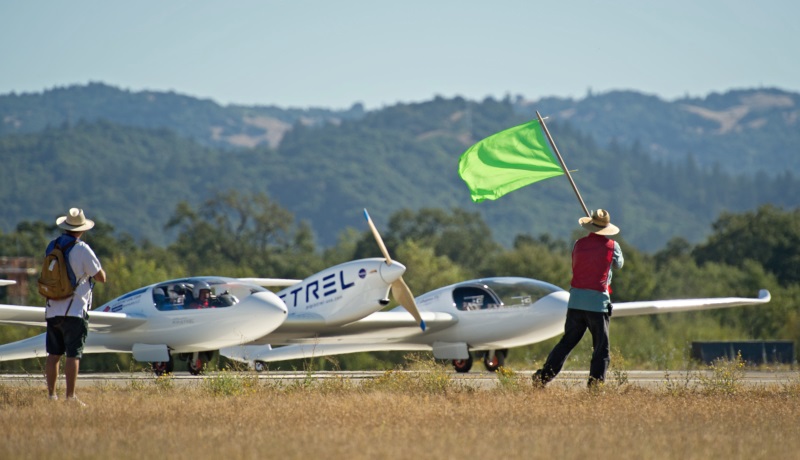
The Taurus G4 was powered by a 150 kW (200 HP) electric motor, driving a two-bladed propeller. With EU funding, the Taurus G4's battery pack was removed, and replaced with a hydrogen-powered fuel cell system. It was first flown in this configuration in 2016.
BACK_TO_TOP* Following up the success of the Virus, Pipistrel decided to develop a four-seat follow-on, with the first flight of the "Panthera" on 4 April 2013.
As it emerged, the sleek Panthera had the composite construction and tee tail of the Virus -- but it had a low wing, with upturned wingtips, and retractable tricycle landing gear with electrical actuation. It was powered by a flat-six air-cooled Lycoming IO-540 engine, driving a three-bladed variable-pitch prop. Early on, the plan was to use the Lycoming IO-390 flat-four engine with 160 kW (210 HP), but was fussier about fuel, so the decision was made to go to the IO-540. Fuel supply was 210 liters (55 US gallons), with the tanks in the wings.
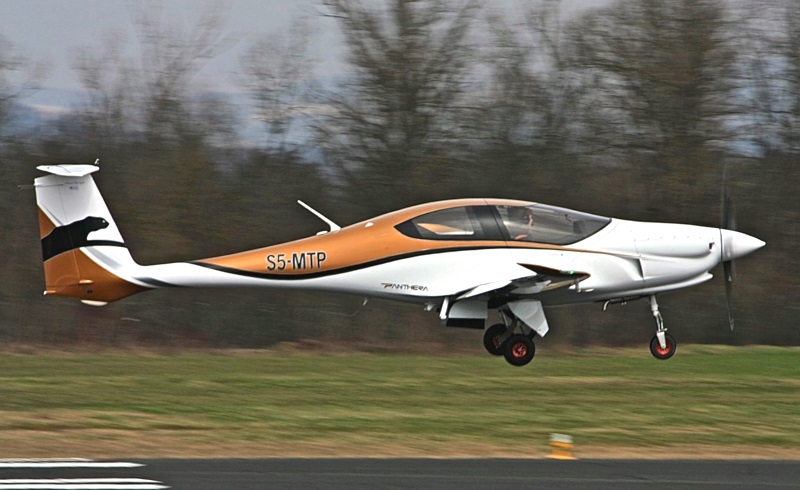
The Panthera had a Garmin glass cockpit, and a ballistic parachute was standard. There were top-hinged doors for pilot and copilot, plus a single top-hinged door on the left for the passengers in the back seats. There was a baggage hold in the rear of the cabin, with an access door on the left.
____________________________________________________________________
PIPISTREL PANTHERA:
____________________________________________________________________
wingspan:
10.86 meters (35 feet 8 inches)
wing area:
11.2 sq_meters (121 sq_feet)
length:
8.07 meters (26 feet 6 inches)
height:
2.19 meters (7 feet 2 inches)
empty weight:
815 kilograms (1,797 pounds)
MTO weight:
1,315 kilograms (2,900 pounds)
cruise speed:
360 KPH (225 MPH / 195 KT)
service ceiling:
7,600 meters (25,000 feet)
range:
1,900 kilometers (1,200 MI / 1,000 NMI)
____________________________________________________________________
Production of the Panthera went on hold, as Pipistrel focused on drones. The Panthera was made available as an experimental-category kitbuilt; certification and production is expected in 2024.
Pipistrel is planning two further variants -- both with 145 kW (190 HP) electric motors, one with pure battery power, the other a hybrid, with a combustion engine running a generator. The Electro and Hybrid variants will only have two seats. Funding for their development was partly provided by the EU.
* The latest effort by Pipistrel has been the "Nuuva" series of cargo drones. The company's "Nuuva V300" design, as unveiled, was a hybrid-electric vertical take-off & landing (VTOL) uncrewed long-range large-capacity autonomous cargo drone. It was a tandem-wing aircraft, with a low-mounted wing up front and a high-mounted wing in front. There was a boom under each front wing, leading a tailfin topped by a short trailing boom under each rear wing -- with three electrically-driven two-blade props on top of the lower boom, and a similar prop on top of the end of each upper boom. These eight props were to be used for vertical lift, being stopped in a fore-aft orientation for forward flight, which would be driven by a three-blade pusher prop in the rear -- powered by an internal-combustion engine, which also turned a generator to power the eight VTOL props. The nose section tilted up for access to the cargo hold.
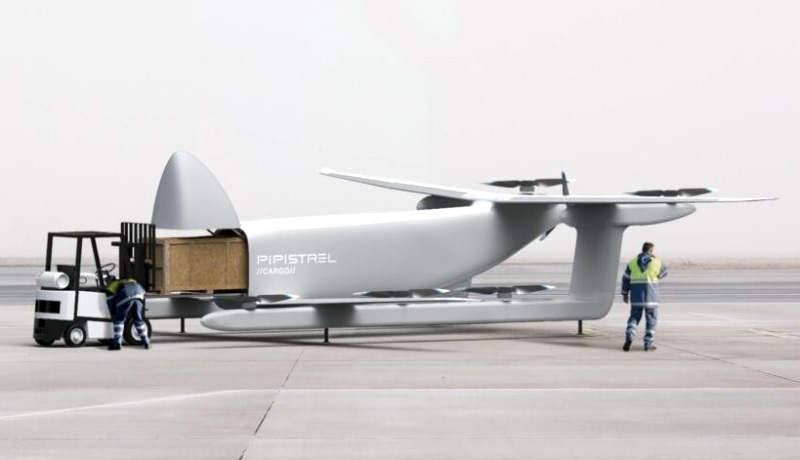
Top speed of the Nuuva V300 was given as 220 KPH (135 MPH), while maximum payload was 450 kilograms (1,000 pounds), with typical loads about two-thirds that. Typical range was about 300 kilometers (185 miles), depending on load. Flight would be autonomous, as per a flight plan. Pipistrel is also working on a scaled-down version, the "Nuuva V20", with a payload of about 20 kilograms (44 pounds). The company says the Nuuva 300 will cost only a tenth as much as a helicopter of similar capability, while being quieter, safer, and more reliable due to its simpler construction. Introduction of the Nuuva has been delayed; it is interesting to speculate the delay had something to do with the war in Ukraine, since the Nuuva could be very useful for special operations -- and Pipistrelle is linked to US SOCOM.
Roughly in parallel, Pipistrel also investigated the "electric vertical take-off / landing (eVTOL)" craze that was emerging at the time. Their baseline concept was the "801" eVTOL -- a purely battery-powered aircraft, with fixed slight-swept high wings, a tee tail with an electrically-driven prop in front of the tailplane, and a pod inboard on each wing with four electrically-driven lift fans, eight lift fans in all. It was to be autonomous in operation, no pilot, with five passenger seats, and a range of 100 kilometers (60 miles).
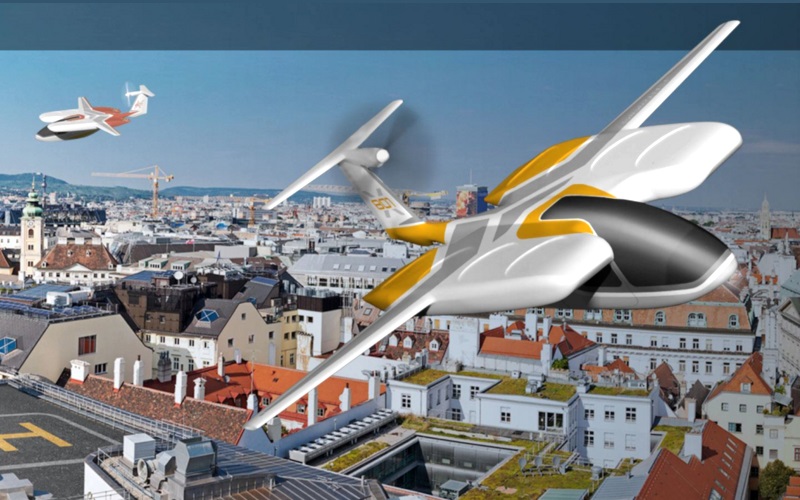
The 801 was more or less designed in response to the "Elevate" program, directed by rideshare giant Uber, and publicly unveiled at the Elevate conference in 2019. As it turned out, the eVTOL push turned out to be over-hyped, and Pipistrel accordingly scaled back ambitions, with the company focusing on cargo drones for the time being. Paper studies for passenger-carrying eVTOL machines have continued, for example a 19-passenger eVTOL "Miniliner", with hybrid propulsion. However, it appears nothing in particular is in the works at present.
BACK_TO_TOP* Pipistrelle was bought out in 2022 by US aircraft giant Textron, with the original company identity and sites being retained for the moment. Textron officials said the purchase was all about getting into the hybrid-electric aviation market -- which is likely true, but one wonders how much the SOCOM connection with the company played into the purchase.
* There were few formal sources for this document, with details scavenged from my library of JANE'S ALL THE WORLD'S AIRCRAFT and online sources, including the Pipistrelle website.
* Illustrations credits:
* Revision history:
v1.0.0 / 01 jul 22 v1.0.1 / 01 jun 24 / Review, update, & polish. (+)BACK_TO_TOP
